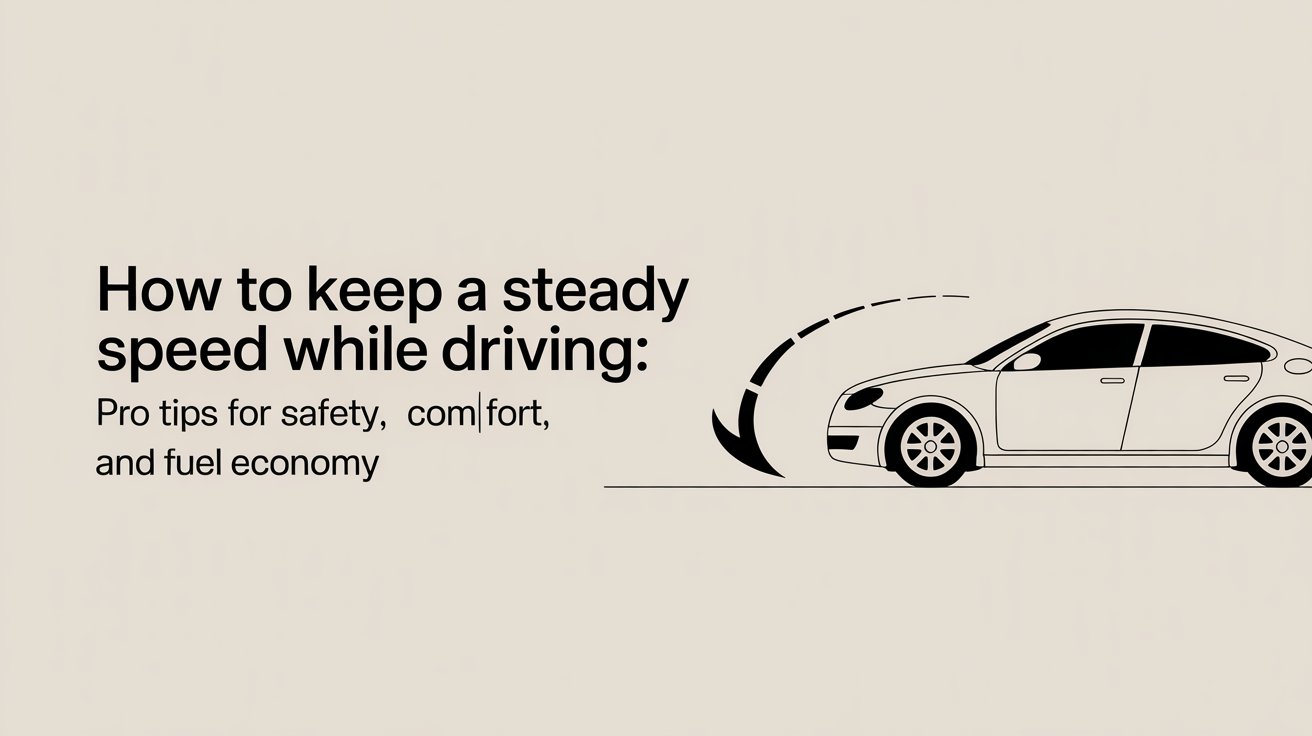How to Keep a Steady Speed While Driving: Pro Tips for Safety, Comfort, and Fuel Economy

Driving smoothly is more than just a comfort factor—it directly impacts your safety, fuel economy, and overall driving experience. Many drivers struggle with the issue of speed fluctuations, often without realizing it. Accelerating too quickly, slowing down unnecessarily, or failing to anticipate traffic can all lead to an inconsistent pace. Learning how to keep a steady speed while driving is a skill that pays off in many ways, from saving money on gas to avoiding accidents. In this article, you will learn practical, human-tested strategies and advanced tips that help drivers of all skill levels maintain consistency on the road.
Why Steady Speed Matters
Maintaining a steady speed goes beyond following speed limits—it’s about controlling your vehicle with awareness and foresight. Safety is the most immediate benefit: drivers who hold a consistent pace are less likely to be involved in rear-end collisions because they reduce sudden stops and accelerations. It also gives other drivers around you a better chance to predict your movements.
Fuel efficiency is another major benefit. Vehicles consume the most fuel when drivers repeatedly accelerate and brake. By keeping a steady pace, you minimize wasted energy and reduce carbon emissions. Studies on eco-driving techniques show that consistent speed can improve fuel economy by as much as 15%.
Finally, comfort cannot be overlooked. Passengers appreciate a smooth ride without abrupt jerks, and drivers themselves feel less fatigued when they do not constantly adjust the accelerator or brake.
Core Driving Techniques
Even without advanced technology, any driver can hold a steady pace by applying some fundamental techniques. One of the most effective is looking farther ahead on the road. Instead of staring at the car directly in front of you, anticipate traffic flow by watching several vehicles ahead. This reduces the need for sudden speed changes.
Throttle discipline is equally important. Instead of heavy foot pressure and quick releases, train yourself to apply gentle, gradual pedal movements. It’s also wise to choose the right lane: often, the far-right lane on highways moves at a steadier pace, while the middle and left lanes are more prone to sudden surges and slowdowns.
Spacing is another game-changer. Following too closely means you must constantly brake and accelerate. Keeping a safe time gap—typically two to three seconds—creates room to adjust smoothly rather than abruptly. Finally, when approaching hills or facing strong headwinds, avoid the temptation to push harder on the accelerator. Instead, maintain steady throttle input, let the car naturally lose a little speed uphill, and regain it on the flat or downhill stretch.
Using Cruise Control the Right Way
Cruise control is one of the most valuable tools for maintaining a steady speed, especially on long highway trips. When used properly, it can prevent unintentional speeding and reduce fatigue. However, it’s important to know when to use it. Cruise control is best on dry, open highways with light traffic. Avoid it in rain, snow, ice, or heavy traffic where constant manual adjustments are safer.
Setting your cruise control slightly below the posted speed limit can also help avoid tickets while giving you a cushion for traffic flow. Remember to keep your foot near the brake or cancel button in case of sudden changes ahead. Many drivers make the mistake of reactivating cruise too quickly after slowing down—this can cause unnecessary surges. Instead, reset it once traffic stabilizes.
Adaptive Cruise Control (ACC)
Newer cars feature adaptive cruise control (ACC), which automatically adjusts your speed based on the vehicle ahead. ACC uses radar or cameras to maintain a safe following distance while keeping a consistent pace. It is especially useful in light to moderate traffic where speeds fluctuate gently.
To maximize ACC, set a safe following distance. Short distance settings may feel convenient, but they often lead to abrupt slowdowns. Long distance settings provide smoother, steadier adjustments. That said, drivers must remain alert—ACC does not handle all conditions well, particularly in heavy rain, sharp curves, or when another car cuts into your lane. Think of ACC as an assistant, not an autopilot.
Intelligent Speed Assistance (ISA) and Speed Limiters
In some regions, Intelligent Speed Assistance (ISA) is becoming mandatory. Unlike cruise control, ISA uses GPS and camera data to identify speed limits and either alert you when you exceed them or actively limit your speed. This technology prevents accidental speeding and encourages steadier pacing.
While not yet common worldwide, ISA highlights the growing role of technology in making steady driving easier and safer. Drivers should still stay aware, since not all speed signs are detected perfectly.
Apps and In-Car Tools That Help
Modern vehicles and smartphones offer digital helpers for maintaining consistent speed. Navigation apps like Google Maps and Waze provide audio alerts when you exceed speed limits, while some advanced head-up displays project your speed directly onto the windshield for quick reference.
For drivers who want to track habits, OBD-II devices and telematics apps provide feedback on acceleration, braking, and average speed consistency. This helps you recognize bad habits, such as fluctuating speed during simple commutes.
Vehicle Setup and Maintenance
Your car’s condition plays a huge role in how easily you can maintain steady speed. For example, improperly inflated tires or poor alignment increase rolling resistance, making your vehicle harder to control smoothly. Similarly, clogged air filters or worn spark plugs can cause sluggish throttle response, leading to inconsistent acceleration.
Carrying unnecessary weight—such as heavy cargo or roof racks—can also cause subtle speed fluctuations, particularly on inclines. Keeping your car in top condition not only improves safety and efficiency but also helps your vehicle respond predictably to your inputs.
Terrain and Traffic Playbook
Different driving environments require different strategies for keeping speed steady. On freeways, the best approach is to stay in a lane that matches your preferred speed rather than constantly switching lanes. On urban arterials, timing traffic lights by watching pedestrian signals or using “green wave” timing helps reduce stop-and-go behavior.
When driving on hilly routes, momentum management is key. Rather than pressing hard uphill and then braking downhill, allow natural speed changes while keeping your throttle steady. In construction zones or residential areas with speed bumps, a constant low speed works better than constant braking and accelerating.
EV-Specific Tips
Electric vehicles (EVs) introduce unique opportunities for steady driving. Many EVs feature “one-pedal driving,” where regenerative braking slows the car as you lift off the accelerator. To avoid jerky motion, learn to feather the pedal lightly instead of releasing it suddenly. Adaptive cruise in EVs can also manage stop-and-go traffic more smoothly, though it may impact battery range slightly.
Beginner Drills to Build Consistency
New drivers often find it challenging to keep a constant speed. Simple exercises can help. One drill is the “needle lock,” where you try to hold the speedometer needle within a two-kilometer range for several minutes. Another is the “metronome throttle,” where you apply rhythmic, controlled pedal pressure on a flat road. On hilly roads, practice maintaining pedal position rather than chasing speed. These exercises sharpen your sensitivity to vehicle response and help you internalize smooth control.
Troubleshooting Common Problems
If you find yourself constantly speeding up or slowing down, the issue might be where you focus your attention. Looking too closely at the car ahead leads to overreactions. Expanding your vision reduces these fluctuations. Tailgaters can also pressure you into speeding or slowing—avoid this by changing lanes rather than adjusting your pace unnaturally.
Sometimes the problem lies with the vehicle itself. Issues such as misaligned tires or faulty throttle sensors can cause uneven performance. Regular maintenance checks help eliminate mechanical causes.
Quick Checklist
- Pre-drive: Check tire pressure, route, and speed alert settings.
- On the road: Look far ahead, keep safe following distance, use smooth inputs.
- Technology: Engage cruise/ACC wisely, set alerts, adjust following distance.
- Post-drive: Review trip computer for fuel economy and average speed steadiness.
FAQs
Is it better to hold steady speed or steady throttle on hills?
Steady throttle is more efficient—allowing slight speed changes uphill prevents wasted fuel.
When should I avoid cruise control?
Avoid it in wet, icy, or heavy stop-and-go traffic conditions.
Does adaptive cruise control keep speed steadier than human driving?
In light traffic, yes. It reacts faster and maintains distance more consistently.
Do steady speeds really save fuel?
Yes—up to 15% improvement in fuel economy depending on conditions.
Conclusion
Learning how to keep a steady speed while driving is a skill that pays off in safety, comfort, and fuel efficiency. By combining mindful driving habits, the right use of technology, and proper vehicle maintenance, anyone can master the art of consistent driving. Whether you’re on a cross-country highway or navigating city streets, a steady pace ensures smoother rides, reduced stress, and a safer road for everyone.
Do Read: What Is Living in Australia Like in 2025? (Cost, Jobs, Housing, Lifestyle & Visas)







